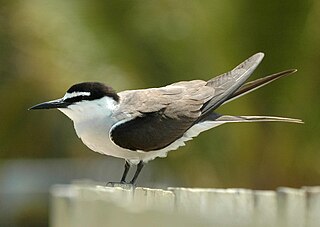
The bridled tern is a seabird of the family Laridae. It is a bird of the tropical oceans. The scientific name is from Ancient Greek. The genus comes from onux meaning "claw" or "nail", and prion, meaning "saw". The specific anaethetus means "senseless, stupid".

Giovanni Antonio Scopoli was an Italian physician and naturalist. His biographer Otto Guglia named him the "first anational European" and the "Linnaeus of the Austrian Empire".

The spotted dove or eastern spotted dove is a small and somewhat long-tailed pigeon that is a common resident breeding bird across its native range on the Indian subcontinent and in Southeast Asia. The species has been introduced to many parts of the world and feral populations have become established.

The red-billed leiothrix is a member of the family Leiothrichidae, native to southern China and the Himalayas. Adults have bright red bills and a dull yellow ring around their eyes. Their backs are dull olive green, and they have a bright yellow-orange throat with a yellow chin; females are somewhat duller than males, and juveniles have black bills. It has also been introduced in various parts of the world, with small populations of escapees having existed in Japan since the 1980s. It has become a common cagebird and amongst aviculturists it goes by various names: Pekin robin, Pekin nightingale, Japanese nightingale, and Japanese (hill) robin, the last two being misnomers as it is not native to Japan.
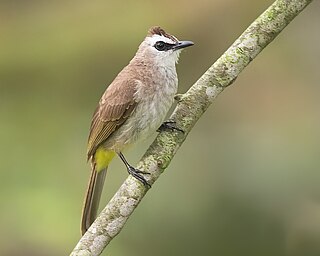
The yellow-vented bulbul, or eastern yellow-vented bulbul, is a member of the bulbul family of passerine birds. It is a resident breeder in southeastern Asia from Indochina to the Philippines. It is found in a wide variety of open habitats but not the deep forest. It is one of the most common birds in cultivated areas. They appear to be nomadic and roam from place to place regularly.

The black lory, is a medium-sized, blackish parrot with black bill, dark grey feet and long rounded tail. It has yellow and red under-tail. The sexes are similar. It is native to West Papua in Indonesia.

The Asian glossy starling is a species of starling in the family Sturnidae. It is found in Bangladesh, Brunei, India, Indonesia, Malaysia, Myanmar, the Philippines, Singapore, Taiwan (introduced), Cambodia and Thailand. Its natural habitats are subtropical or tropical moist lowland forest and subtropical or tropical mangrove forest. There is also a huge number of this species inhabiting towns and cities, where they take refuge in abandoned buildings and trees. They often move in large groups and are considered one of the noisiest species of birds. In the Philippines, it is known as kulansiyang, galansiyang, or kuling-dagat.
The spice imperial pigeon is a species of bird in the family Columbidae. It is endemic to Indonesia, where it occurs in the eastern Moluccas and the Raja Ampat Islands. Its natural habitats are subtropical or tropical moist lowland forests and subtropical or tropical mangrove forests. It eats, and is an important disperser of seeds for, fleshy fruits.

The brown-hooded kingfisher is a species of bird in the subfamily Halcyoninae, the tree kingfishers. It has a brown head and blackish and turquoise wings. It is found in Sub-Saharan Africa, living in woodland, scrubland, forest edges, and also suburban areas. The International Union for Conservation of Nature (IUCN) has assessed it as being of least concern.

The blue whistling thrush is a bird in the Old World flycatchers family Muscicapidae that is found in the mountains of Central Asia, South Asia, China and Southeast Asia. It is known for its loud human-like whistling song at dawn and dusk. The widely distributed populations show variations in size and plumage with several of them considered as subspecies. Like others in the genus, they feed on the ground, often along streams and in damp places foraging for snails, crabs, fruits and insects.

Caradrina clavipalpis, the pale mottled willow, is a moth of the family Noctuidae. The species was first described by Giovanni Antonio Scopoli in his 1763 Entomologia Carniolica. It is found in the Palearctic realm. It is an introduced species in North America, where it was first reported from Queens in New York City in 1993. In 2009 it was found in Rochester, New York, so it appears to be established and spreading.
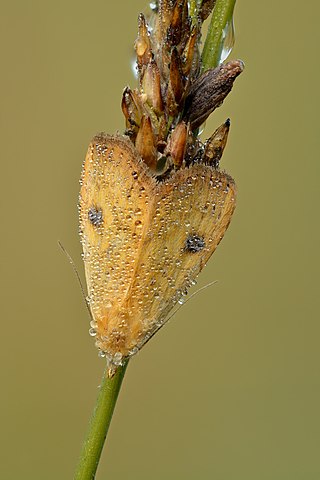
Rivula sericealis, the straw dot, is a moth of the family Noctuidae. The species was first described by Giovanni Antonio Scopoli in his 1763 Entomologia Carniolica. It is found in Europe including the Iberian Peninsula and southern Fennoscandia and south to North Africa. In an easterly direction, the species occurs across the Palearctic to the Pacific Ocean and Japan. The species closely resembles Evergestis forficalis.
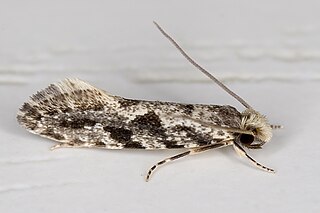
Nemapogon granella is a species of tineoid moth. It belongs to the fungus moth family (Tineidae), and therein to the subfamily Nemapogoninae. It is the type species of its genus Nemapogon, and via that also of the subfamily Nemapogoninae. It is also the type species of the proposed genera Brosis and Diaphthirusa, which are consequently junior objective synonyms of Nemapogon.

Stenoptilia bipunctidactyla, also known as the twin-spot plume is a moth of the Pterophoroidea family found in North Africa, Asia and Europe. It was first described by the Austrian physician and naturalist, Giovanni Antonio Scopoli in 1763. It is one of four similar looking moths.

Polydontes is a genus of air-breathing land snails, terrestrial pulmonate gastropod molluscs in the subfamily Polydontinae of the family Sagdidae.

Morum oniscus is a species of sea snail, a marine gastropod mollusk in the family Harpidae, the harp snails.

Acrotylus is a genus of grasshopper in the family Acrididae and the type genus of the tribe Acrotylini.

Ruspolia nitidula, the Large Conehead, is a species belonging to the subfamily Conocephalinae of the family Tettigoniidae. It is found throughout Europe, Africa, and the Palearctic part of Asia. A vernacular name that has been used is "cone-headed grasshopper", although it is not a grasshopper, but rather a bush cricket.
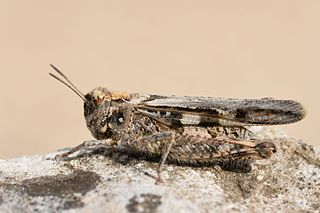
Acrotylus fischeri is a species of band-winged grasshopper in the family Acrididae. It is found in southern Europe and northern Africa.

Acrotylus longipes is a species of band-winged grasshopper in the family Acrididae. It is found in Europe, North Africa, and western Asia.



















